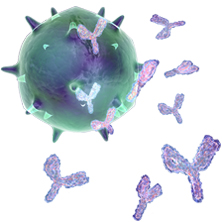Raffalli C, Clouet E, Kuresepi S, Damiens MH, Lepoittevin JP, Pallardy M, Ferret PJ, Giménez-Arnau E, Kerdine-Römer S Toxicology Science, 2017 ABSTRACT: Allergic contact dermatitis (ACD) is regarded as the most frequent expression of immunotoxicity in humans. Many odorant terpenes commonly used in fragrance compositions are considered as weak skin sensitizers, whereas some of their… Read more »

This system includes the lymph nodes, white blood cells, lymphatic vessels, thymus gland, bone marrow, spleen and leukocytes. Common disorders include anything with bacterial, viral or fungal origins, leukemia, allergic reactions and autoimmune diseases like lupus or rheumatoid arthritis.
Anti-edematogenic and anti-inflammatory activity of the essential oil from Croton rhamnifolioides leaves and its major constituent 1,8-cineole (eucalyptol)
Martins AOBPB, Rodrigues LB, Cesário FRAS, de Oliveira MRC, Tintino CDM, Castro FFE, Alcântara IS, Fernandes MNM, de Albuquerque TR, da Silva MSA, de Sousa Araújo AA, Júniur LJQ, da Costa JGM, de Menezes IRA, Wanderley AG Biomedicine & Pharmacotherapy, 2017 ABSTRACT: The species Croton rhamnifolioides, belonging to the Croton genus, is known in ethnomedicine… Read more »
Evaluation of the Constituents of Vetiver Oil Against Anopheles minimus (Diptera: Culicidae), a Malaria Vector in Thailand
Tisgratog R, Sukkanon C, Grieco JP, Sanguanpong U, Chauhan KR, Coats JR, Chareonviriyaphap T Journal of Medical Entomology, 2017 ABSTRACT: The development of resistance by mosquitoes to current synthetic compounds has resulted in reduced effectiveness of prevention and control methods worldwide. An alternative nonchemical based control tools are needed to be evaluated particularly plant-derived essential oils…. Read more »
Combined Toxicity of Three Essential Oils Against Aedes aegypti (Diptera: Culicidae) Larvae
Muturi EJ, Ramirez JL, Doll KM, Bowman MJ Journal of Medical Entomology, 2017 ABSTRACT: Essential oils are potential alternatives to synthetic insecticides because they have low mammalian toxicity, degrade rapidly in the environment, and possess complex mixtures of bioactive constituents with multi-modal activity against the target insect populations. Twenty-one essential oils were initially screened for their toxicity against… Read more »
Repellency Effect of Essential Oils of some Native Plants and Synthetic Repellents against Human Flea, Pulex irritans (Siphonaptera: Pulicidae)
Ghavami MB, Poorrastgoo F, Taghiloo B, Mohammadi J Journal of Arthropod Borne Disease, 2017 BACKGROUND: Fleas are important vectors of human and animal disease, and control measures for protection against their bites and flea-borne diseases are necessary. METHODS: The essential oils (EOs) of four native medicinal plants, Ziziphora tenuiore, Myrtus communis, Achillea wilhelmsii and Mentha piperita were isolated by hydrodistillation technique and analyzed… Read more »
Perspectives on medicinal properties of natural phenolic monoterpenoids and their hybrids
Rajput JD, Bagul SD, Pete UD, Zade CM, Padhye SB, Bendre RS Molecular Diversity, 2017 ABSTRACT: Carvacrol, thymol and eugenol belong to a class of naturally presenting phenols with a ten-carbon unit, which are present in essential oils of many plants. These versatile molecules are incorporated as useful ingredients in many food products and find applications in… Read more »
Cytotoxic and genotoxic potential of geraniol in peripheral blood mononuclear cells and human hepatoma cell line (HepG2)
Queiroz TB, Santos GF, Ventura SC, Hiruma-Lima CA, Gaivão IOM, Maistro EL Genetics and Molecular Research, 2017 ABSTRACT: Geraniol is an acyclic monoterpene alcohol present in the essential oil of many aromatic plants and is one of the most frequently used molecules by the flavor and fragrance industries. The literature also reports its therapeutic potential, highlighting itself… Read more »
Toxic and repellent activity of selected monoterpenoids (thymol, carvacrol and linalool) against the castor bean tick, Ixodes ricinus (Acari: Ixodidae)
Tabari MA, Youssefi MR, Maggi F, Benelli G Veterinary Parasitology, 2017 ABSTRACT: The castor bean tick, Ixodes ricinus, is a species of medical and veterinary importance. The use of synthetic acaricides for tick control has led to development of resistance, residues in the environment and animal products, and public health concerns. In this regard, plant essential… Read more »
Chemical composition, anti-biofilm activity and potential cytotoxic effect on cancer cells of Rosmarinus officinalis L. essential oil from Tunisia
Jardak M, Elloumi-Mseddi J, Aifa S, Mnif S Lipids in Health and Disease, 2017 BACKGROUND: Rosmarinus officinalis L. from Tunisia, popularly known as rosemary, is of a considerable importance for its medicinal uses and aromatic value. The aim of this study was to examine the chemical composition of Rosmarinus officinalis essential oil (ROEO) and to evaluate its… Read more »
Synergistic effect of eugenol, carvacrol, thymol, p-cymene and γ-terpinene on inhibition of drug resistance and biofilm formation of oral bacteria
Miladi H, Zmantar T, Kouidhi B, Al Qurashi YMA, Bakhrouf A, Chaabouni Y, Mahdouani K, Chaieb K Microbial Pathogenesis, 2017 ABSTRACT: Dental caries remains the most prevalent oral infectious disease worldwide. In this study, the antibacterial and the antibiofilm activities of five essential oils (EO’s): eugenol (EUG), carvacrol (CAR), thymol (TYH), p-cymene (CYM) and γ-terpinene (TER) were… Read more »
